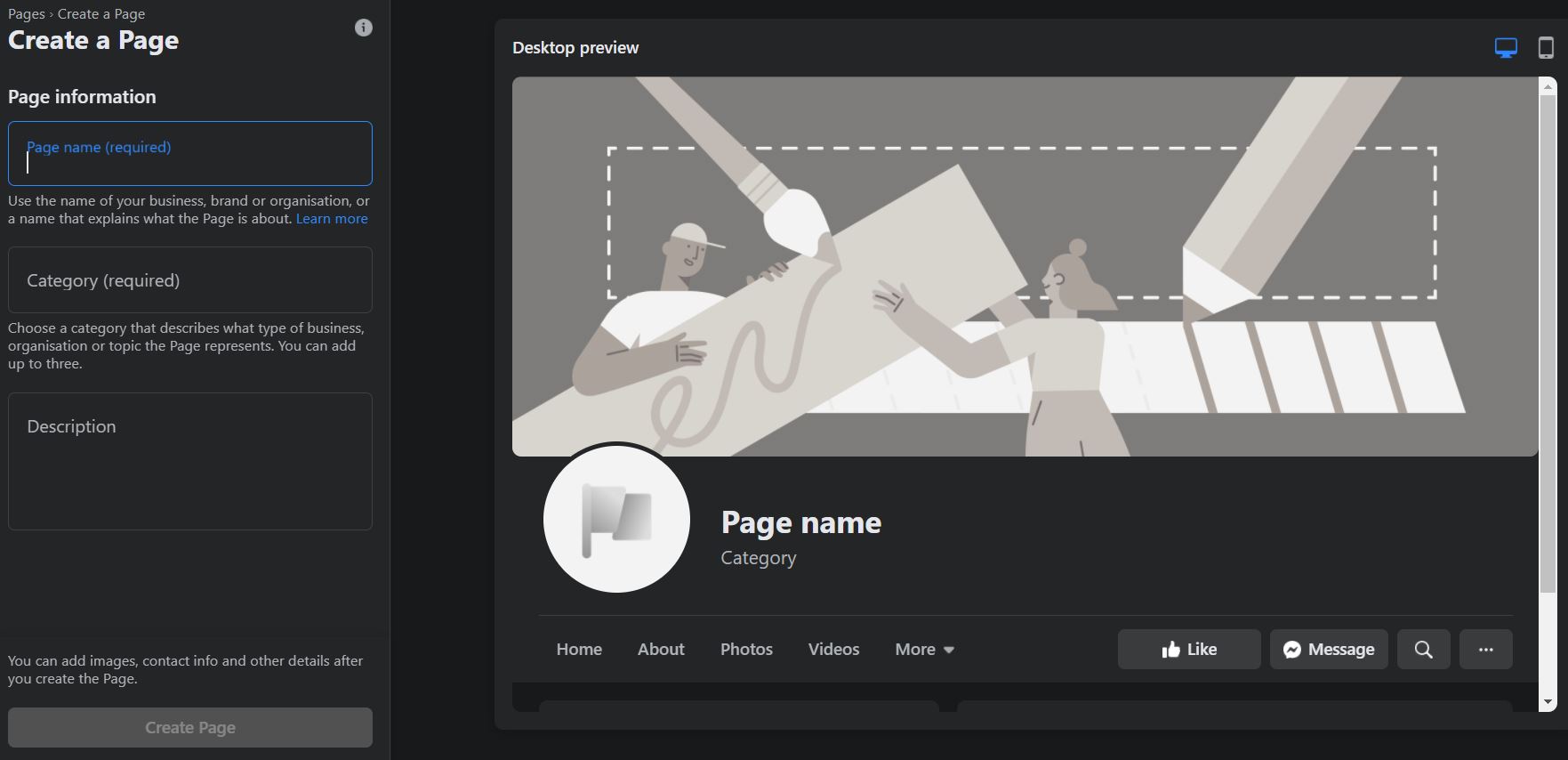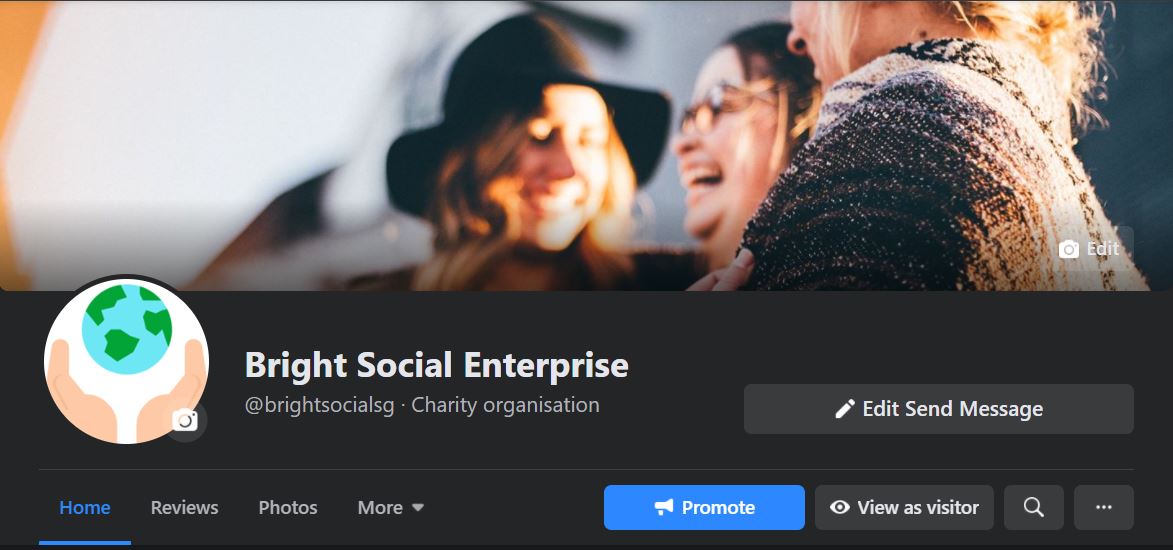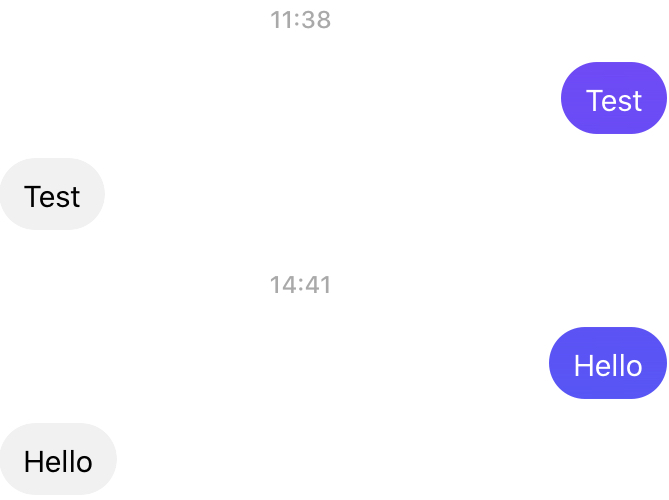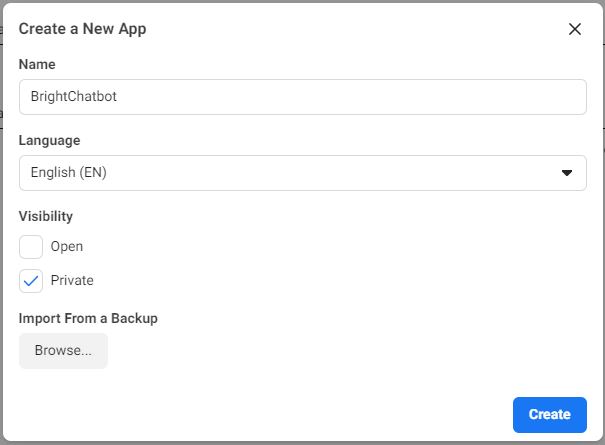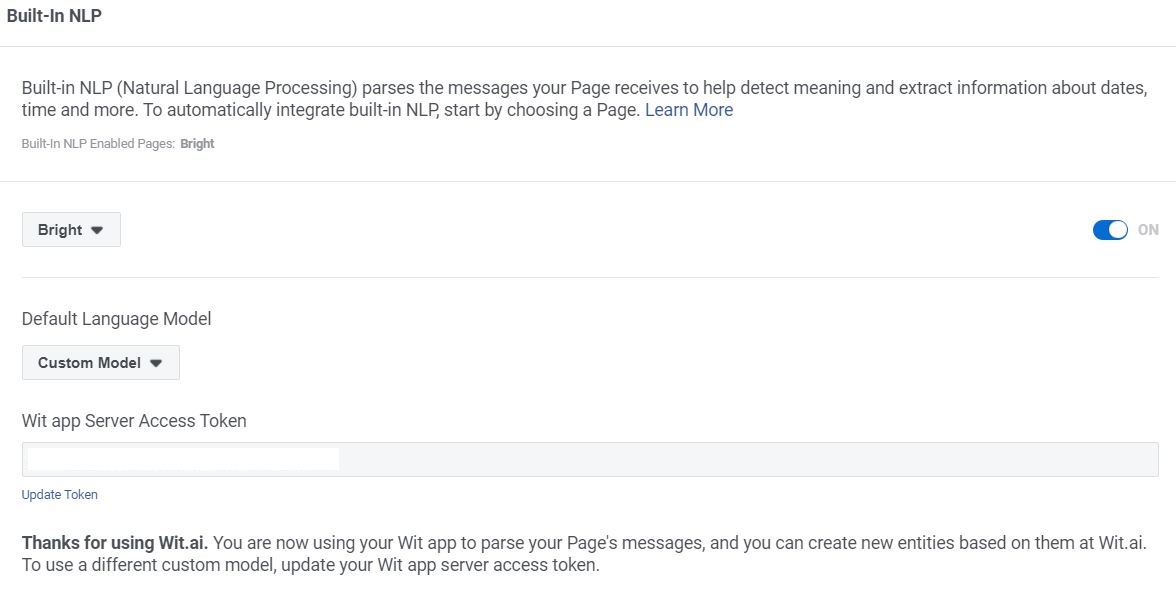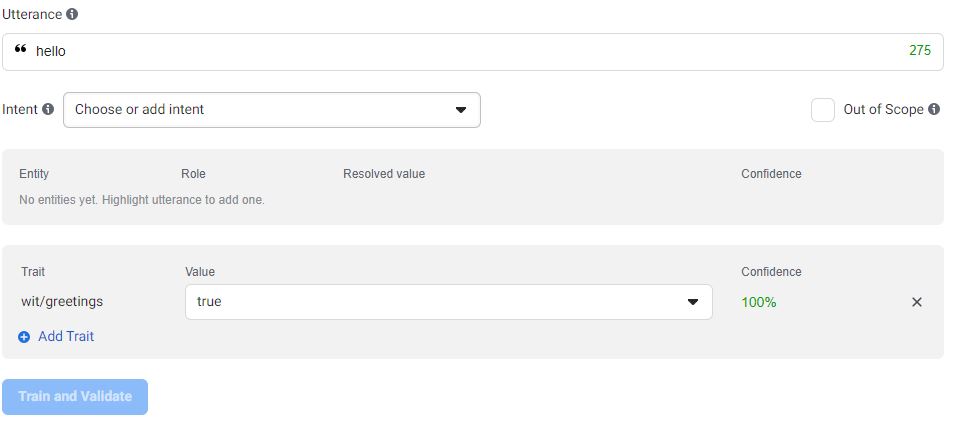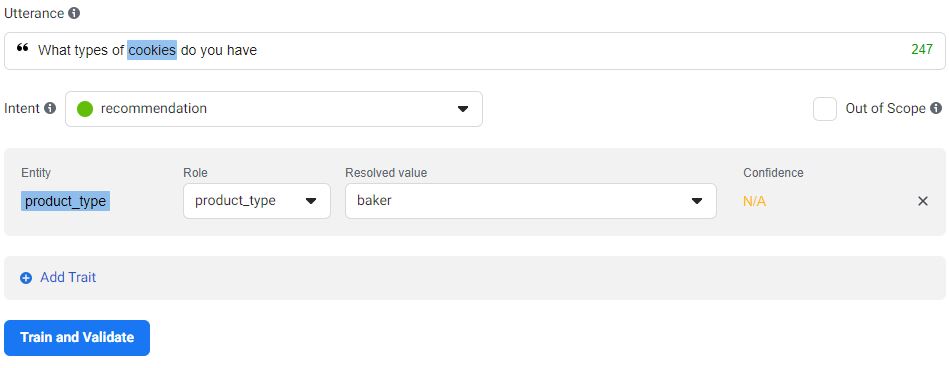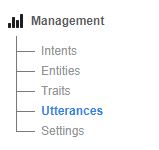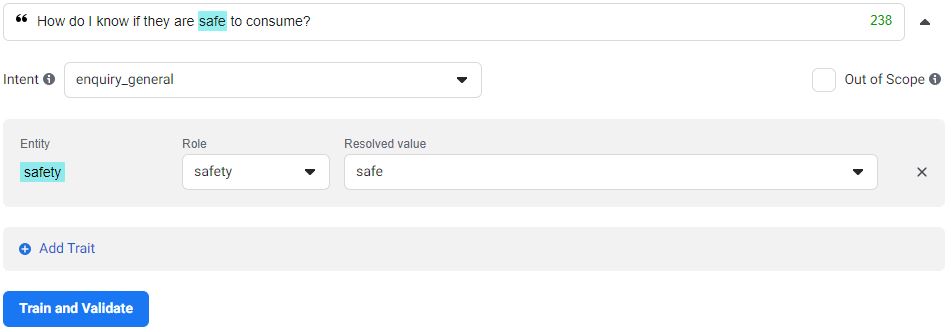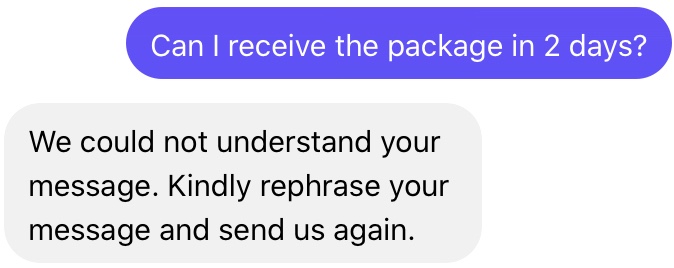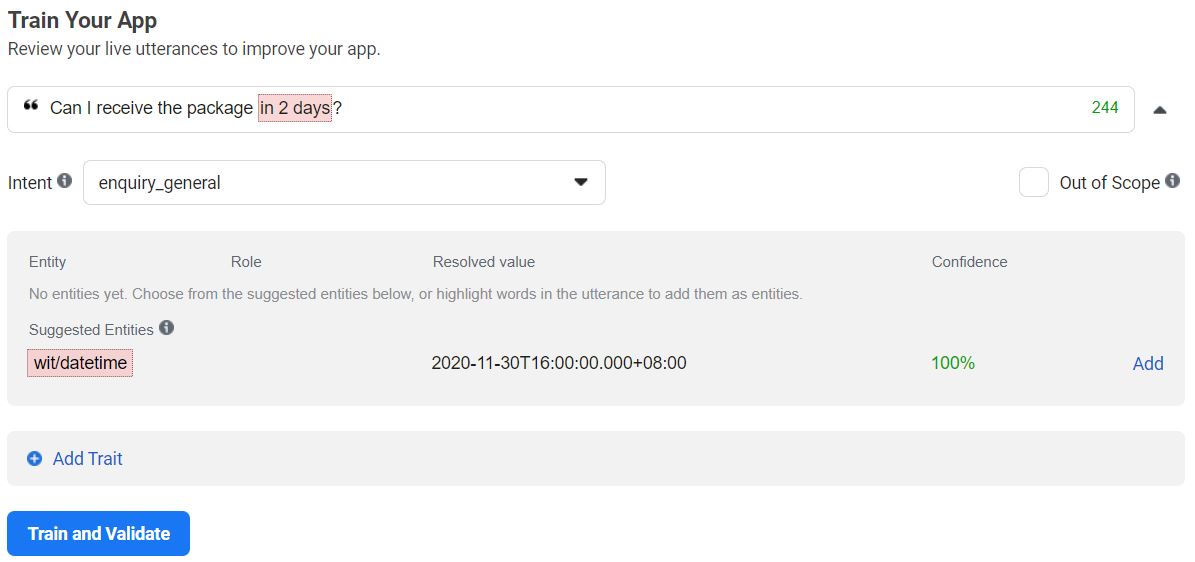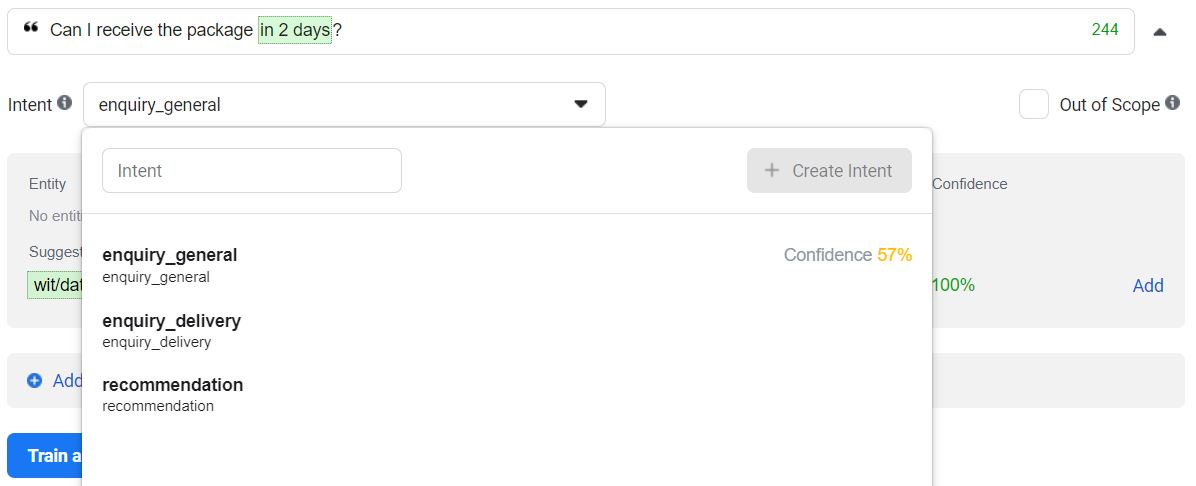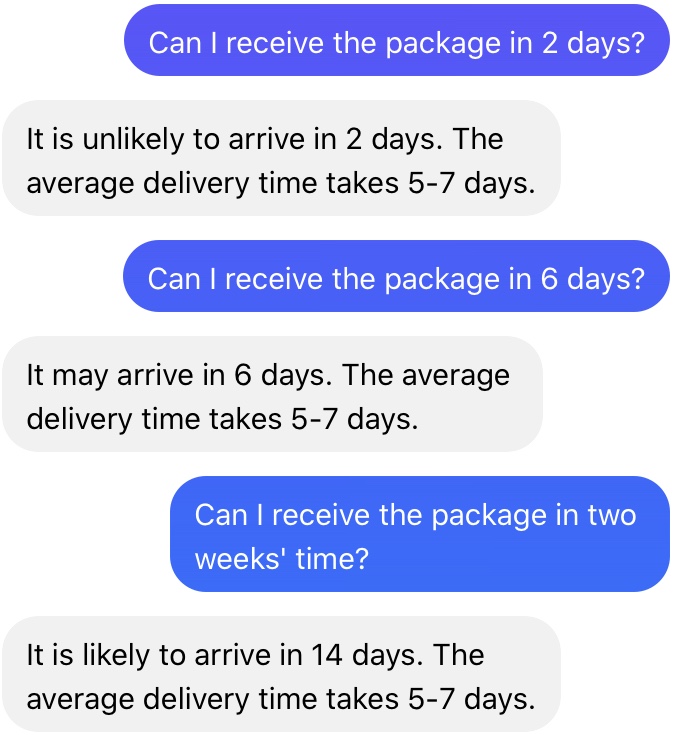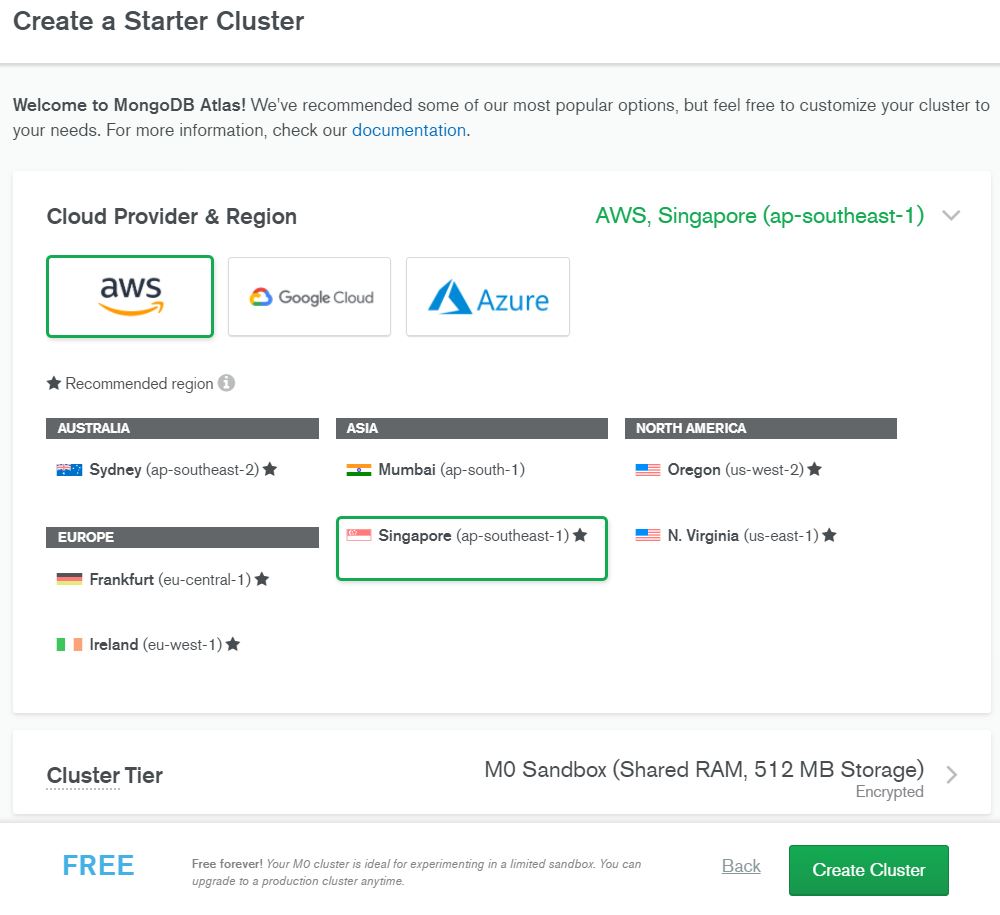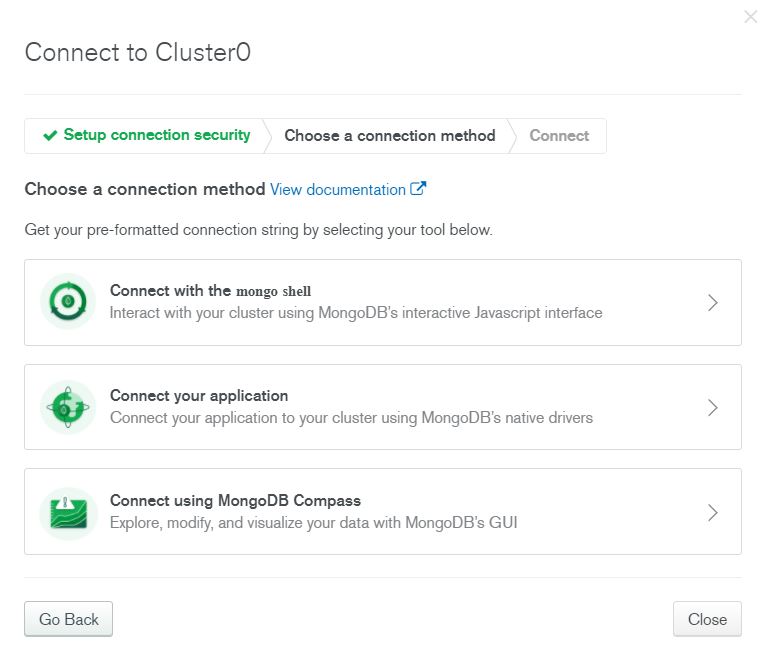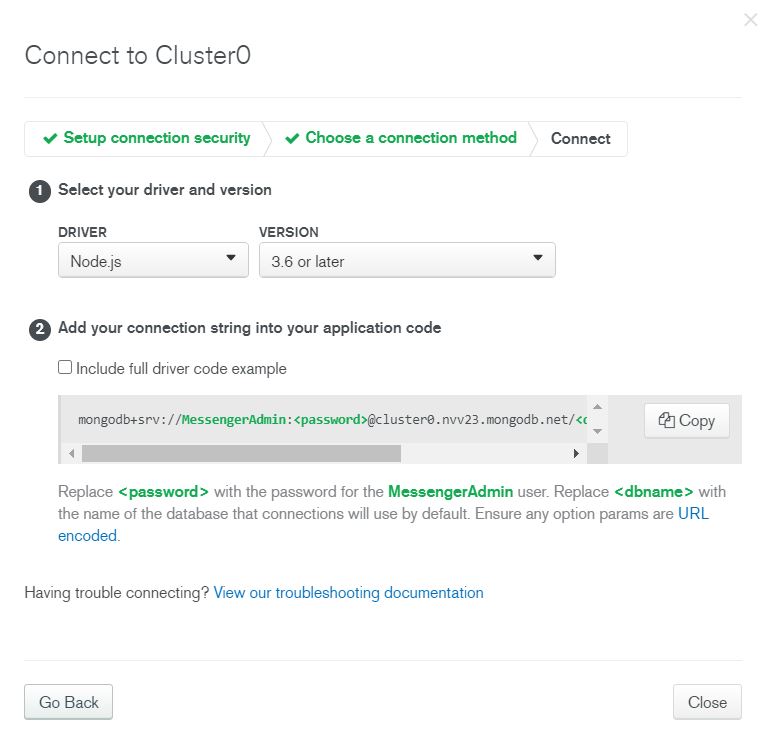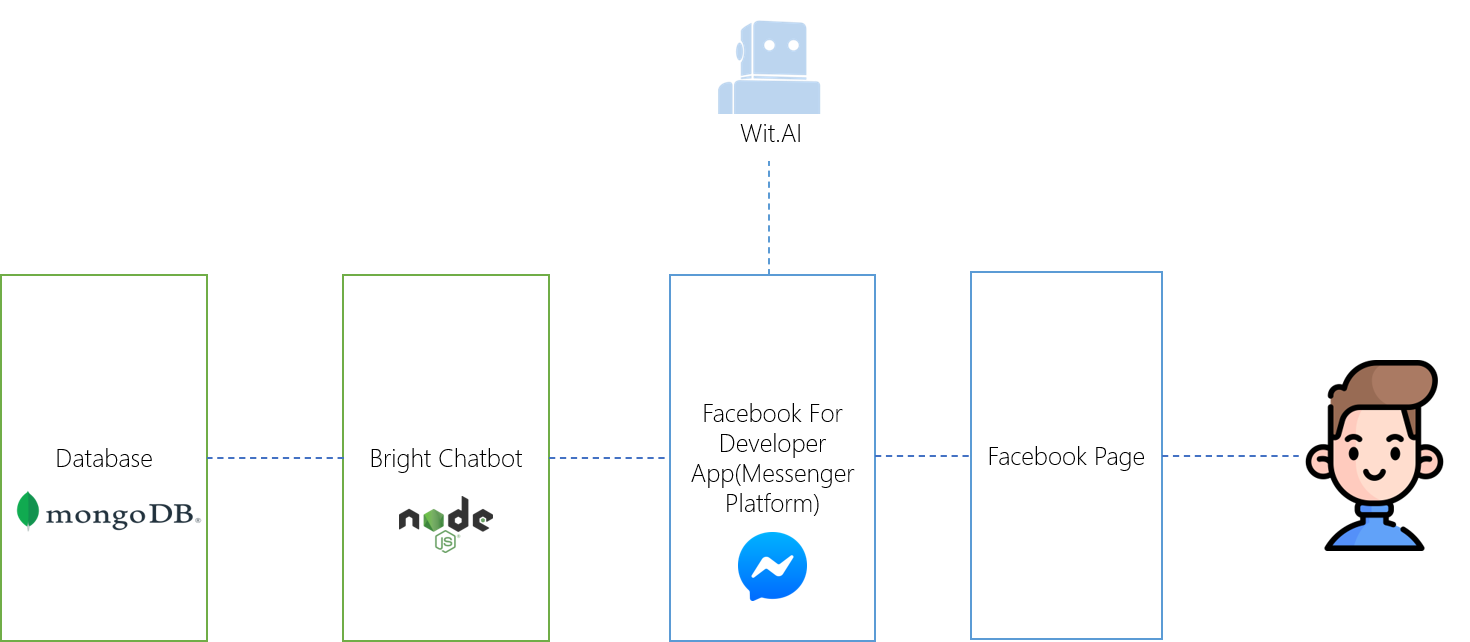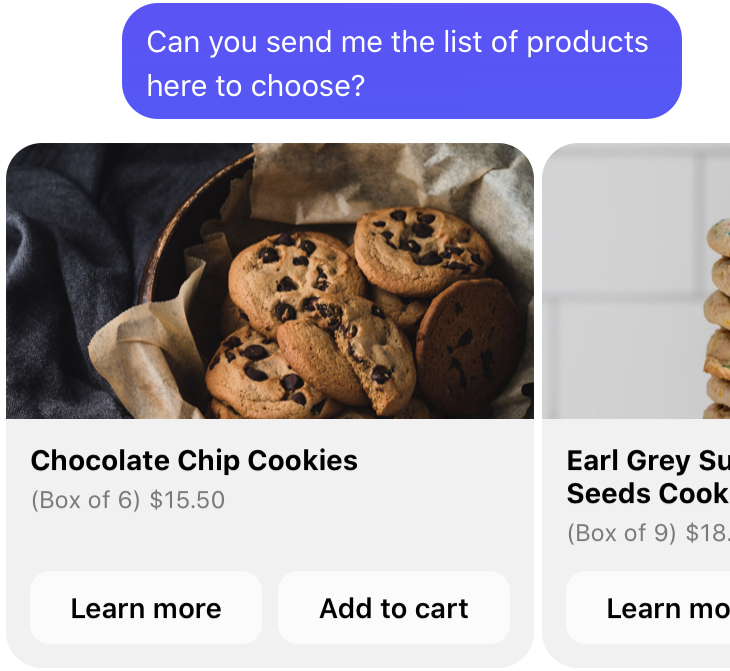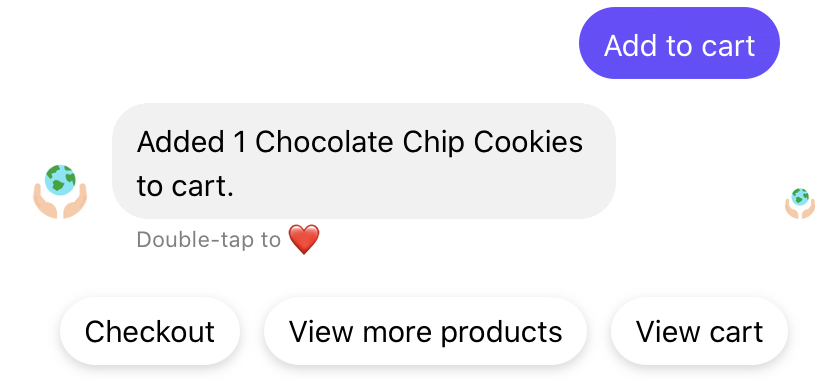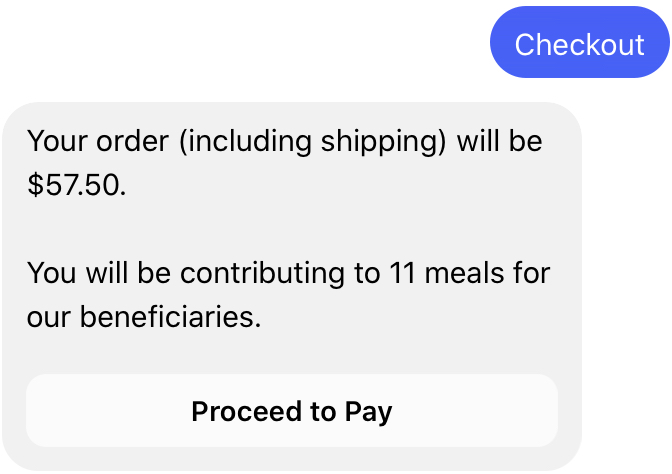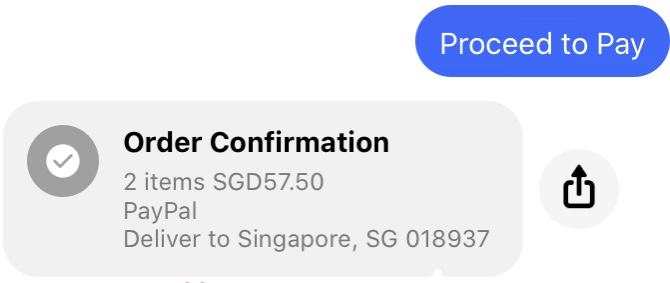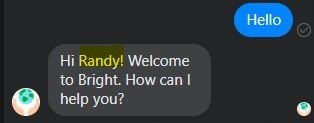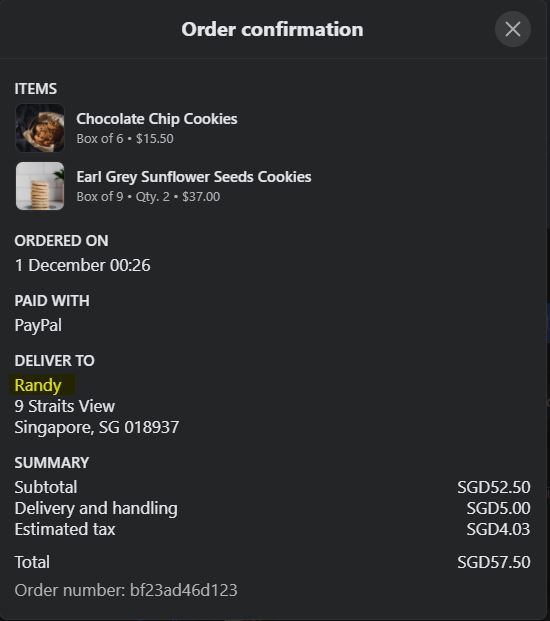Table of Contents
- Create Smarter Messenger Experiences on Facebook with Bright Commerce Chatbot
- Introduction
- Pre-Requisites
- Sending and Receiving Messages
- Introduction to
Wit.aiNatural Language Processing (NLP)- Creating a Customised
Wit.aiApplication - Connecting the Custom
Wit.aiNLP Model to your Facebook for Developers App - Example of a Built-in Trait
- Training the Model to Understand the Intent of a Message
- Training the Model to Understand the Entity in a Message
- Adding more Training Data
- Making Changes in the Management Tab
- Evaluating Performance and Additional Training
- Training with Inputs from Users
- More on
Wit.aiIntegration with Facebook Messenger
- Creating a Customised
- Processing Messages with NLP
- Option 1: Creating a Business Database
- Option 2: Adding Mock Commerce Data in
index.js - Solution Overview
- Listing Products
- Adding to Cart
- Checkout
- Personalising Replies with User's First Name using Facebook Graph API
- Challenge 1: Order Enquiry
- Challenge 2: Implement Product Enquiries
- Wrapping Up
- Acknowledgements
- References
- Tutorial GitHub Link
- Devpost Submission
Chatbots are the face of customer service across many businesses as it is a form of automation that enables them to free up manpower for other operations. Businesses can greatly benefit from these efficiency gains and alleviate their lack of manpower through automating their chat services.
Consumers are increasingly using ecommerce sites to replace their everyday shopping needs. Some users prefer human-like interactions in their shopping experiences and the technologies used to build chatbots have become intelligent enough to create immersive chat experiences without human intervention.
We felt that this business case would be a good example to showcase the functionalities of a Messenger chatbot and introduce budding chatbot developers to the tools needed to get started on their own messaging commerce platforms using their Facebook Pages and Wit.ai.
The following subsections list the background knowledge and pre-requisites to create a chatbot.
Basic Javascript knowledge on objects, conditional statements, and functions will be helpful in the implementation of Bright chatbot. Specific knowledge on Node.js is also used in this tutorial, which acts as the server to handle communications between Bright and Facebook.
Browse the following resources below to learn more about the technologies used:
- JavaScript: https://javascript.info/
- Basic Node.js: https://www.w3schools.com/nodejs/
Git is a version control system that will be mainly used to update code used to build the chatbot. More information on Git can be found on https://git-scm.com/
We recommend versioning your code on a GitHub repository.
Creating a Facebook Page is a key step in your journey to creating a Messenger experience. Here are a few simple steps to help you get started:
- Go to https://www.facebook.com/pages/create - it should lead you to a page shown below
- Fill in your page information
- Add images - adding a profile and cover image is important to allow others to identify your business
Congratulations! You have completed the setup of your Facebook Business Page! Next up, is on how to create a Messenger Bot for your page!
After creating your very own Facebook Page for your business, you will want a way to communicate with your customers. Before even going into the details on how to create a chatbot, what better way is there to direct users to send messages to you when they visit your page than having a 'Send Message' button?
This button should be found at the top of your page. Click on Add a Button and select the Send Message option.
Customize your personal message to your customers when they first start communicating with your page through Messenger. So how do we go about doing this?
- Go to your page’s General Settings and select Messaging
- Scroll down and turn on Show a greeting
- Customise your greeting and click Change
Create a set of creative responses for frequently asked questions regarding your business. This is highly recommended before creating your chatbot as it helps you brainstorm on what customers may ask and lets you implement various prompts for users to interact with your page on Messenger.
Here is how you can do it:
- Under Manage Page, select Inbox
- In the left menu sidebar, select Automated Responses
- Enable Frequently Asked Questions
- Click Edit
- Add questions and responses (remember to save your responses with the Save button on the top right!)
These are the important few steps to getting started before you can develop your chatbot to serve your users using code.
- Head to https://developers.facebook.com, click on My Apps
- Click on Create App, located on the top right of the screen
- Select Manage Business Integration
- Enter your App Display Name and App Purpose
- After creating the app, on the side bar, click on add products, leading you to the Add Products section on the main page. Find the Messenger product and click Set Up
Next, the following steps will be detailed in the next two sections. To summarise:
- You will have to generate a page access token by adding a new page to the Messenger product, after clicking on the Add or Remove Pages button, select your Facebook page that you would like to add. After adding the page, you will be able to see a Generate Token button, which will give you a page access token that will be used on your Node.js for communication with Facebook via the Send API.
- Set up a callback URL by entering your callback URL (location where your Node.js server is hosted) and also enter the verify token (which is a random string) that is determined by you in the Node.js server during the Node.js server setup. Lastly, click on Verify and Save to confirm your callback URL.
- Now you’re ready to test the app, go to Messenger, and type a message to your Page. If your Node.js server (with the callback URL) receives a webhook event, you’ve successfully set up your app to receive messages!
Webhooks are API endpoints which you expose, to allow client(s) to connect to. This allows the users to interact to either send data or collect data from your servers. In this case, we are using this endpoint as an interaction between your webhook and your Facebook for Developers App, to send and receive data from our chatbot on your Facebook business page.
- Create a directory (folder), and navigate into it via the command line
- Next, create an empty,
index.jsfile in your project folder - Issue the command,
npm initon the command line, accept default for all questions, and this will createpackage.jsonin your project folder automatically. - Issue the command,
npm install express body-parser --save, this installs the Express.js http server framework module, and add them as dependencies in yourpackage.jsonfile - Create a server that listens for communication at the default port by adding the following code below into your
index.jsfile
'use strict';
// Imports dependencies and set up http server
const
express = require('express'),
bodyParser = require('body-parser'),
app = express().use(bodyParser.json()), // creates express http server
dotenv = require('dotenv');
dotenv.config();
// Sets server port and logs message on success
const listener = app.listen(process.env.PORT || 1337, () => console.log('webhook is listening on port ' + listener.address().port));
app.get('/', (req, res) => {
res.status(200).send('You are connected to the chatbot application.');
})- Let us now create a
GETrequest/webhookendpoint for your Facebook for Developers App to verify the webhook. We suggest adding your verification token in a.envfile.
// Adds support for GET requests to our webhook
app.get('/webhook', (req, res) => {
// Your verify token. Should be a string you set.
let VERIFY_TOKEN = process.env.VERIFY_TOKEN;
// Parse the query params
let mode = req.query['hub.mode'];
let token = req.query['hub.verify_token'];
let challenge = req.query['hub.challenge'];
// Checks if a token and mode is in the query string of the request
if (mode && token) {
// Checks the mode and token sent is correct
if (mode === 'subscribe' && token === VERIFY_TOKEN) {
// Responds with the challenge token from the request
console.log('WEBHOOK_VERIFIED');
res.status(200).send(challenge);
} else {
// Responds with '403 Forbidden' if verify tokens do not match
res.sendStatus(403);
}
}
});- Finally, you can now test your webhook by issuing the curl command (replace the
<VERIFY_TOKEN>with your own token that you had specified in the previous step:
curl -X GET "localhost:1337/webhook?hub.verify_token=<VERIFY_TOKEN>&hub.challenge=CHALLENGE_ACCEPTED&hub.mode=subscribe"As the chatbot's callback URL requires a HTTPS endpoint, we recommend hosting the chatbot on Heroku. The guide on how to deploy can be found at https://devcenter.heroku.com/articles/getting-started-with-nodejs?singlepage=true
Next, to connect to a Git repository, you can utilise the GitHub integration in Heroku, which allows for automatic deployment whenever your main branch is updated https://devcenter.heroku.com/articles/github-integration
So how can you connect with Facebook?
- Go to your Application that you have created earlier in https://developers.facebook.com
- Select Messenger and click Settings
- Insert your server’s Callback URL, followed by
/webhook. In this tutorial the webhook endpoint ishttps://<url>/webhook. Note here that the URL has to be served with HTTPS, or else you would not be able to connect to Facebook
Note that the verify token is like a shared secret that Facebook has between you and your application for them to authenticate the connection to the callback URL.
This is how it looks like if you have successfully added the webhook callback URL:
There you have it, you have successfully connected your chatbot application with Facebook!
Sending messages require the use of Send API via a POST request coupled with your page access token included in your URL query string.
Below is a wrapper function that takes in the sender’s identifier (called Page-scoped ID, or PSID in short) and the response object. This function converts parameters into the standardised data structure and proceeds to send the response.
// Sends response messages via the Send API
function callSendAPI(sender_psid, response) {
// Construct the message body
let request_body = {
messaging_type: 'RESPONSE',
recipient: {
id: sender_psid
},
message: response
};
// Send the HTTP request to the Messenger Platform
request(
{
uri: "https://graph.facebook.com/v8.0/me/messages",
qs: { access_token: process.env.PAGE_ACCESS_TOKEN },
method: "POST",
json: request_body
},
(err, res, body) => {
if (!err) {
console.log("Message sent!");
} else {
console.error("Unable to send message: " + err);
}
}
);
}In the request_body, the recipient’s ID is the sender of the messenger, which can be referenced by the PSID. This allows us to specify which user the message response is for, and for the Messenger Platform to route to the right user. The message attribute in the request_body simply refers to the response of the message that you will like to send back.
In order to make a HTTP request to the Messenger Platform, we will use the request package. More information on that package can be found here: https://www.npmjs.com/package/request.
The request object takes in
uri: The URI of the Send APIqs: Query string parameters that will be attached to the URLPAGE_ACCESS_TOKENjson: Request body JSON that you had created
To get the PAGE_ACCESS_TOKEN, navigate to your App on Facebook for Developers. Under Access Tokens, click Add or Remove Pages. Add your page and click Generate Token. Read and check I Understand, then create a .env file and paste the token.
Your .env file should now look like this:
PAGE_ACCESS_TOKEN=<page_access_token>
VERIFY_TOKEN=<verify_token>
Create a .gitignore and add .env inside (if you have not). Also, add the variables to Heroku. In our script, we the dotenv package is used to configure and retrieve the page access token.
The start of your index.js should look like this (remember to add the new dependencies in package.json too):
// Imports dependencies and set up http server
const
express = require('express'),
bodyParser = require('body-parser'),
app = express().use(bodyParser.json()), // creates express http server
dotenv = require('dotenv'),
request = require('request');
dotenv.config();Once all these components are in place, you’re ready to execute standard responses back to the sender. Let us try automating some standard responses!
We first define a wrapper function sendMessage that takes in sender_psid and message (of string type), converts the string to a response object, then sends the message. This function might seem unnecessary now, but is definitely useful when the scale of the chatbot gets larger.
// Wrapper method to convert text message string to response object, and sends the message
function getResponseFromMessage(message) {
const response = {
text: message
};
return response;
}We will first start by responding to the same message as what the user sent.
// Creates the endpoint for our webhook
app.post('/webhook', (req, res) => {
let body = req.body;
// Checks this is an event from a page subscription
if (body.object === 'page') {
// Iterates over each entry - there may be multiple if batched
body.entry.forEach(function(entry) {
// Gets the message. entry.messaging is an array, but
// will only ever contain one message, so we get index 0
let webhook_event = entry.messaging[0];
let sender_psid = webhook_event['sender']['id'];
let message = webhook_event['message']['text'];
console.log('Message received from sender ' + sender_psid + ' : ' + message);
let response = getResponseFromMessage(message);
callSendAPI(sender_psid, response);
});
// Returns a '200 OK' response to all requests
res.status(200).send('EVENT_RECEIVED');
} else {
// Returns a '404 Not Found' if event is not from a page subscription
res.sendStatus(404);
}
});Try it out! You should see the following behaviour:
Now let us implement some standard reponses. First, replace sendMessage with a new processMessage function that will be implemented.
The processMessage function encapsulates the implementation of the standard responses.
function processMessage(message) {
message = message.toLowerCase();
let responses = {
hi: "Hi there! Welcome to Bright. How can I help you?",
bright: "Bright is a social enterprise where we provide vocational training to adults with intellectual disabilities.\n\n" +
"We started a range of social enterprise projects to provide alternative work engagement opportunities for our adult trainees. " +
"Some of the projects began as therapy programmes which encourage the development of fine motor skills; others provide a realistic vocational training environment.\n\n" +
"All net revenue earned from the sale of our products and services go towards paying a monthly allowance for our clients' work, as well as their lunch expenses while undergoing training.",
proceeds:
"All net revenue earned from the sale of our products and services go towards paying a monthly allowance for our clients' work, as well as their lunch expenses while undergoing training.",
support:
"We support adults with intellectual disabilities. We started a range of social enterprise projects to provide alternative work engagement for our adult trainees.",
sell: "We sell craft and baker goods.\nLike our Facebook page http://fb.me/brightsocialsg to stay updated!",
safe: "Our cookies are made by our clients in a clean and sanitised environment. The cookies are safe to consume before the expiry date that is printed on the packaging."
};
for (const key in responses) {
if (message.includes(key)) {
return getResponseFromMessage(responses[key]);
break;
}
}
// Message does not match any keyword, send default response
return getResponseFromMessage("We could not understand your message. Kindly rephrase your message and send us again.");
}Now, whenever your message includes any of those keywords in the responses object, a standard response message will be sent.
Wit.ai is a NLP service that provides a user-friendly interface to facilitate training your Facebook Messenger chatbot. Using its own NLP engine, Wit.ai is essentially used to build the “brain” of Bright chatbot.
Sign in to Wit.ai using Facebook and click on New App.
Let's name our application BrightChatbot and make its visibility Private. Click on Create.
Congratulations, you’ve now made your first Wit.ai application.
We will now connect the NLP model to your Facebook for Developers application. This is done by going to your Facebook for Developers application’s Messenger Settings page and toggling the built-in NLP option for your page under the Built-In NLP section.
Although Messenger comes with a default NLP engine with Wit.ai, we are training our own custom NLP model on Wit.ai.
To connect your Wit.ai model to your Facebook for Developers application, you will first need to generate a Server Access Token. Generating your Server Access Token is simple. In Wit.ai, click on the Settings on the left tab (under Management).
Under Server Access Token, click Generate New Token and your access token will be generated.
Copy the Access Token and head over to the Facebook for Developers application's Messenger Settings page. Then, under Built-In NLP, click on the dropdown for Default Language Model and select Custom Model. Paste the server access token into the textbox field.
Congratulations, your Wit.ai NLP model has been successfully connected to your Facebook chatbot application!
We will now spending some time training our Wit.ai model to understand our custom intents and entities for our use case, to make our chatbot more capable of handling the messages it may face.
Back to the Wit.ai model, you will see three tabs titled Understanding, Management and Insights on the left. Let’s start by training our chatbot on the Understanding tab.
Click the Understanding tab. A sentence, such as a question to the chatbot, is known as an utterance. The intention behind this utterance is quite simply, the intent.
Wit.ai has built-in entities that can be readily used for a number of common conversation topics. We often start off a conversation with a greeting and Wit.ai has a corresponding trait called wit/greetings. Traits are used to capture intents from the whole utterance.
Our Wit.ai application is pre-trained to identify a number common greetings. Whether you type “hello”, “hi” or even “aloha” in the Utterance section, the trait will be identified as wit/greetings.
Let’s train the chatbot to understand a generic question seeking a product recommendation.
In the Utterance tab, type the utterance “I want to buy something”. Click the Choose or add intent drop-down list and create new intent recommendation.
Click Train and Validate.
- You will see Training scheduled followed by Training ongoing on the top right-hand corner as
Wit.aitrains to identify the recommendation intent from your sentence - Training complete is shown when the training is finished
During the training process, there is no need to wait for the previous utterance’s training to complete before training new utterances. You can keep training new utterances back-to-back as the training process for each utterance can run in parallel on Wit.ai.
What if instead of a general recommendation, the buyer wants to specifically buy a type of product such as cookies? We classify "cookies" as baker type products and would need the chatbot to recognise "cookies" as the product_type entity.
Set utterance as “What types of cookies do you have?”
The intent is recommendation by default as that’s the only intent we have trained so far.
To identify the intent, highlight "cookies":
Create the entity product_type. The entity is now shown prior to training. For more complicated sentences with multiple entities, you can highlight and label them one by one.
Change the Resolved value to baker as we want the cookies to be identified as being in the baker category.
Now Train and Validate. The chatbot’s learning is not limited to only the utterances shared through Understand. The model itself will be able to infer additional ways the same question or utterance can be asked based on the few examples provided by you.
Let’s train the chatbot to understand more utterances and intents to help it better understand future queries. Train it with the following:
| Utterance | Intent |
|---|---|
| How do I know if they are safe to consume? | enquiry_general |
| I need help | enquiry_general |
| When is delivery coming? | enquiry_delivery |
| When is my order arriving? | enquiry_delivery |
| What kind of cookies do you have? | recommendation |
| Can you send me the list of products here to choose? | recommendation |
We have added in a few more recommendation intents as well, to help the model further differentiate between the three unique entities.
Oops, we forgot to add entities to the sentences in bold in the table we used for training earlier! Let’s add the entities using the Management tab.
Click on Management, then Utterances.
Find the sentence “How do I know if they are safe to consume” that you have previously trained the chatbot with and click on the down arrow beside it.
You can now add entities to it! Highlight the word "safe" and add an entity called safety.
Now, train! That’s really all there is to training your chatbot and managing it on Wit.ai.
Deletions of any intents, entities and utterances can be handled in the management tab and their respective sections.
Before we conclude with a test of our training’s accuracy, update the entities for the following two sentences that we have previously trained:
- When is my delivery coming?
- When is my order arriving?
Set their entities to estimated_arrival for the text "when".
Test your chatbot and see whether it can correctly identify the intents for these questions.
| Utterance | Actual Intent |
|---|---|
| What would you suggest? | recommendation |
| When will my order be here? | enquiry_delivery |
In this scenario, it should be a success! However, it is completely alright if the model does not recognise all of the intents correctly. In machine learning, the model will only work well with lots and lots of training. Therefore, do remember to train the model with these new data!
We previously trained the chatbot to identify the word "cookies" as being under the entity product_type, with a resolved value of baker. This is meant to represent baked goods.
Let's evaluate the chatbot with this sentence “Do you have many types of cookies?”
You will see that while the model is able to correctly identify the intent and entity, it has a confidence of 79%. This means that the model is only 79% confident that it has correctly identified the entity within the sentence. By adding more training data (i.e. more utterances) to train the model, you can increase its confidence level on a wider array of inputs from consumers.
Note that you can also view the confidence of intents by clicking on the intent dropdown.
What happens if the model is unable to identify the intent or entity (or both!) from an utterance?
Evaluate the model with the sentence “What type of cookie is there?”
The model will correctly identify this as being under the intent recommendation but it cannot match "cookie" to the entity product_type.
To make your model understand these new terms, remember to continuously train it with a larger number of utterances using the steps shown previously in Training the Model to Understand the Intent of a Message and Training the Model to Understand the Entity in a Message sections.
Now you must be thinking, where am I going to find the time to come up with so many different utterances that users could possibly ask? Fret not, as the Wit.ai platform records these messages as they are sent to the bot!
Messages sent to the Facebook Messenger chatbot will only be received by the
Wit.aimodel after theWit.aiapplication has been connected to the Facebook Messenger application. We have shown you how to connect them in an earlier section of our tutorial: Connecting the Custom Wit.ai NLP Model to your Facebook for Developers App!
What is the best way to gather more data to train the model? Our answer: Get the questions from your customers directly! The beauty of Wit.ai is that every message that gets sent to your chatbot gets recorded on the Understanding tab that we used to train our model.
You can simply click the down arrow beside each string of text to open additional options to Train and Validate that utterance (as per what you are already familiar with from the previous sections).
Alternatively, if the utterance is irrelevant, you can mark it as Out of Scope (by checking the checkbox) before clicking on Train and Validate.
Only label an utterance as Out of Scope if you want to train the model to recognise it as one that is not meant to be handled in the future.
Note that upon clicking the intent/entity dropdown, only trained intents and/or entities will be recommended. Should you want to train a new intent and/or entity, you will have to create it from scratch.
This sums up training your chatbot with Wit.ai’s easy-to-use NLP model!
You have finished training your model and integrating it with your Facebook chatbot application, great job! Here is a brief description of how the Wit.ai NLP model integrates with Facebook Messenger for those of you who are more curious.
Messages that are received by the chatbot are inputed to the model to identify intents, entities and traits. When the model detects any of them, it ties each of them to a confidence value.
A confidence value falls between 0 and 1, showing how confident the NLP model is of what has been detected. The closer the confidence is to 1, the more confident the model is of its interpretation. The more you train your model, the better it gets at identifying these values and the more confident it will be in interpreting messages coming from users interacting with your chatbot.
Within your Facebook Messenger webhook, you can handle received messages by setting your own criteria for handling these responses based on the identified intents, entities and/or traits, which are usually based on Wit.ai model. The next section, processing messages with NLP, will discuss this in detail.
Now we are ready to use your Wit.ai model (NLP model) outputs to process messages! Let us first understand how this works. When a user interacts with Bright, the message will first be sent to the NLP model. The outputs of the model will be sent in the message webhook and can be retrieved in the nlp key in the message object.
Let us modify our POST request function to retrieve the NLP model output and pass it in as a new, second argument in processMessage.
console.log('Message received from sender ' + sender_psid + ' : ' + message);
let nlp = webhook_event['message']['nlp'];
let response = processMessage(message, nlp);
callSendAPI(sender_psid, response);Then, wrap the default message in a new getDefaultResponse function, which will be used in early returns and when there are neither intents nor traits found in the message.
function getDefaultResponse() {
return getResponseFromMessage("We could not understand your message. Kindly rephrase your message and send us again.");
}Next, we modify the processMessage function.
// Processes and sends text message
function processMessage(message, nlp) {
if (nlp['intents'].length === 0) {
// Check if greeting
let traits = nlp['traits'];
if (traits['wit$greetings'] && traits['wit$greetings'][0]['value'] === 'true') {
console.log('Is greeting');
return getResponseFromMessage('Hi there! Welcome to Bright. How can I help you?');
}
console.log('Returning default response');
return getDefaultResponse();
}
}By utilising Wit.ai's built-in greetings trait wit/greetings, we are able to leverage on the detection based on pretrained data, which means that we do not have to train greetings like "Hi" ourselves!
We will now train the messages that we have handled with the standard responses in the NLP model. All of the messages are of the same intent enquiry_general, but the entities of the general enquiry are different, which allows us to differentiate between the queries the user has.
| Utterance | Intent | Phrase -> Entity |
|---|---|---|
| Who is Bright? | enquiry_general |
Bright -> organisation |
| Where does your proceeds go to? | enquiry_general |
proceeds -> profit |
| Who makes the products? | enquiry_general |
Who makes -> manufacturer |
| What do you sell? | enquiry_general |
sell -> products |
| How do I know if they are safe to consume? | enquiry_general |
safe -> safety |
To handle general enquiries, we first modify the processMessage function to retrieve the enquiry_general intent and its entities, then abstract the handling of general enquiries into another function handleGeneralEnquiry.
// Processes and sends text message
function processMessage(message, nlp) {
if (nlp['intents'].length === 0) {
...
}
console.log('Intents inferred from NLP model: ')
console.table(nlp['intents']);
// Get the intent with the highest confidence
let intent = nlp['intents'][0]['name']
let confidence = nlp['intents'][0]['confidence']
// If confidence of intent is less than threshold, do not process
if (confidence < 0.7) return getDefaultResponse();
let entities = nlp['entities'];
let highest_confidence = 0;
switch (intent) {
case 'enquiry_general':
// Get entity with highest confidence
let entity = null;
for (const e in entities) {
let confidence = entities[e][0]['confidence'];
if (confidence > highest_confidence) {
highest_confidence = confidence;
entity = entities[e][0]['name'];
}
}
console.log('Entity with highest confidence: ' + entity);
return handleGeneralEnquiry(entity);
default:
return getDefaultResponse();
}
}We had set a arbitrary confidence threshold of 0.7 in order to prevent handling of messages with low confidence scores.
function handleGeneralEnquiry(entity) {
if (entity == null) return getDefaultResponse();
let responses = {
organisation: "Bright is a social enterprise where we provide vocational training to adults with intellectual disabilities.\n\n" +
"We started a range of social enterprise projects to provide alternative work engagement opportunities for our adult trainees. " +
"Some of the projects began as therapy programmes which encourage the development of fine motor skills; others provide a realistic vocational training environment.\n\n" +
"All net revenue earned from the sale of our products and services go towards paying a monthly allowance for our clients' work, as well as their lunch expenses while undergoing training.",
profit:
"All net revenue earned from the sale of our products and services go towards paying a monthly allowance for our clients' work, as well as their lunch expenses while undergoing training.",
manufacturer:
"We support adults with intellectual disabilities. We started a range of social enterprise projects to provide alternative work engagement for our adult trainees.",
products: "We sell craft and baker goods.\nLike our Facebook page http://fb.me/brightsocialsg to stay updated!",
safety: "Our cookies are made by our clients in a clean and sanitised environment. The cookies are safe to consume before the expiry date that is printed on the packaging."
};
return getResponseFromMessage(responses[entity]);
}Let us now work with messages of the enquiry_delivery intent. To recap, the following utterances have been trained to be classified as delivery enquiries:
| Utterance | Intent |
|---|---|
| When is delivery coming? | enquiry_delivery |
| When is my order arriving? | enquiry_delivery |
| When will my order be here? | enquiry_delivery |
Again, we will modify the processMessage function:
// Processes and sends text message
function processMessage(message, nlp) {
...
switch (intent) {
...
case 'enquiry_delivery':
return handleDeliveryEnquiry();
default:
return getDefaultResponse();
}
}This time, we create the function handleDeliveryEnquiry to handle delivery enquiries:
function handleDeliveryEnquiry() {
return getResponseFromMessage('We deliver islandwide. The average delivery time takes 5-7 days.');
}Let's see if the chatbot can handle the message "Can my order arrive in 2 days?". It works!
What about "Can I receive the package in 2 days?". Unfortunately, it is unable to correctly classify the intent based on the response. We will need to investigate why.
The message "Can I receive the package in 2 days?" is wrongly classified as a general enquiry with a confidence score of 0.572 (do note that it is completely normal if your confidence score is different).
Since the message is classified as a general enquiry, did the chatbot handle the message as a general response and return the default response? No. The default response was returned from the processMessage function, as the confidence score is below the threshold of 0.7 that we had set in the previous section.
Even though the model classified the message as a general enquiry, the confidence score of only 0.572 shows that it is unsure of the classification.
So how can we view the confidence score? Previously, we implemented the following logging statements in the processMessage function:
console.log('Intents inferred from NLP model: ')
console.table(nlp['intents']);We can view the score in the webhook's logs in Heroku:
Intents inferred from NLP model:
┌─────────┬────────────────────┬───────────────────┬────────────┐
│ (index) │ id │ name │ confidence │
├─────────┼────────────────────┼───────────────────┼────────────┤
│ 0 │ '1694432440724955' │ 'enquiry_general' │ 0.572 │
└─────────┴────────────────────┴───────────────────┴────────────┘
Similarly, we see that the message is misclassified in the Wit.ai model's Utterance tab:
Let us rectify the misclassified message. Select the Intent dropdown. From the dropdown, we can verify the confidence (57%) in Wit.ai. Click on enquiry_delivery, then click Train and Validate.
In the chatbot, let us send the same message "Can I receive the package in 2 days?". A high confidence score can be seen in both the logs and on Wit.ai.
Intents inferred from NLP model:
┌─────────┬────────────────────┬───────────────────┬────────────┐
│ (index) │ id │ name │ confidence │
├─────────┼────────────────────┼───────────────────┼────────────┤
│ 0 │ '381501166565779' │ 'enquiry_general' │ 0.9959 │
└─────────┴────────────────────┴───────────────────┴────────────┘
The message will be correctly handled.
You have now learnt how the NLP model on Wit.ai is linked to the chatbot and how to build with them!
Notice that Wit.ai has a suggested a date and time entity wit/datetime in the "Can I receive the package in 2 days?" utterance? Similar to the greetings trait wit/greetings, the date and time entity is built-in. The list of built-in entities and traits can be found at https://wit.ai/docs/built-in-entities/
When we modify the enquiry_delivery case in the switch statement of processMessage to log the message's entities, an empty object {} is printed.
// Processes and sends text message
function processMessage(message, nlp) {
...
switch (intent) {
...
case 'enquiry_delivery':
console.log(nlp['entities']);
return handleDeliveryEnquiry();
default:
return getDefaultResponse();
}
}In the Utterance tab, under the "Can I receive the package in 2 days?" utterance, click Add to add the entity. When nlp['entities'] is logged, the date and time entity will be shown:
{ 'wit$datetime:datetime':
[ { id: '222986959252376',
name: 'wit$datetime',
role: 'datetime',
start: 26,
end: 35,
body: 'in 2 days',
confidence: 0.9672,
entities: [],
type: 'value',
grain: 'hour',
value: '2020-11-30T22:00:00.000+08:00',
values: [Array] }
]
}As of the date and time of writing (2020-11-28, 10pm Singapore time), the date and time two days later is 2020-11-30, 10pm. To calculate the date and time, we will need to retrieve the future date in the values attribute.
We modify the processMessage function to pass the entities object as an argument in the handleDeliveryEnquiry function:
// Processes and sends text message
function processMessage(message, nlp) {
...
switch (intent) {
...
case 'enquiry_delivery':
// Get value with highest confidence
let value = null;
if ('wit$datetime:datetime' in entities) {
for (const e of entities['wit$datetime:datetime']) {
console.log(e);
let confidence = e['confidence'];
if (confidence > highest_confidence) {
highest_confidence = confidence;
// Type is either "value" or "interval"
value = (e['type'] === 'value') ? e['value'] : e['to']['value'];
}
}
console.log('Value with highest confidence: ' + value);
}
return handleDeliveryEnquiry(value);
default:
return getDefaultResponse();
}
}Next, we modify the handleDeliveryEnquiry function:
function handleDeliveryEnquiry(value) {
if (value == null) return getResponseFromMessage('We deliver islandwide. The average delivery time takes 5-7 days.');
// Get days between now and date time value and round up
let days = ((new Date(value)) - Date.now()) / (1000 * 60 * 60 * 24);
days = Math.ceil(days);
let message = 'The average delivery time takes 5-7 days.';
if (days < 5) {
message = 'It is unlikely to arrive in ' + days + ' days. ' + message;
} else if (days < 7) {
message = 'It may arrive in ' + days + ' days. ' + message;
} else {
message = 'It is likely to arrive in ' + days + ' days. ' + message;
}
return getResponseFromMessage(message);
}Give it a try! Notice how in the following example, the built-in date and time entity in Wit.ai is able to interpet the term "two weeks" without us training the model.
This section is one of the two options to insert data for Bright to consume. Alternatively, you can find the mock data to be inserted at the top of
index.jsfor chatbot development in the next section.
It is imperative that if you want to build a e-commerce platform, you would need a database to maintain certain details like processing of payments and tracking of delivery status of your products. Here, we are going to give a brief overview on how to create and connect your webhook application to MongoDB, a NoSQL Database.
For the database, we will be using mlabs, a MongoDB Hosting, Database-as-a-service for MongoDB. After signing up with you email at https://mlab.com/, select your cluster and relevant service as seen in the picture below.
Next, click on connect when the database is created, add the ip address of where your server will be, or even your own local ip address for local development. Also, create a user for you to use to connect to your mlabs database in your application.
Select Connect Your Application, then copy and replace the respective fields (your username and password) in your code.
Now onto the code! In your index.js file, include the following:
// Setup to connect to DB
const DB_PASSWORD = process.env.DB_PASSWORD;
mongoose.connect('mongodb+srv://mongoadmin:' + DB_PASSWORD + '@fb-hack-chatbot-cevnk.mongodb.net/fbmsg', { useNewUrlParser: true, useCreateIndex: true, useFindAndModify: false }).then(() => console.log("DB Connection successful"));
mongoose.Promise = global.Promise;This is to setup and allow you to connect to the database that is hosted on mlabs. Next, include the model files that you are going to use in your application.
//Import Schema
require('./models/User');
require('./models/Product');
require('./models/Cart');
require('./models/Order');The model files are all provided in the models folder on GitHub. Their corresponding schemas can be found in these files. Here is an example on how to the schema is written:
const orderSchema = new mongoose.Schema({
customer: { type: mongoose.Schema.Types.ObjectId, ref: 'User' },
trackingNumber: { type: String, unique: true },
orderStatus: {
type: String,
enum : ['Order Received','Packing','Out For Delivery','Delivered','Refund'],
default: 'Order Received'
},
products : [{
title:String,
price:Float,
image_link:String,
pattern:String,
quantity:Float
}]
}, { timestamps: true });The key in the schema object is the name of the column, and value is the database type that you want your column to be in the database. Here we are using mongoose as a library and you can see the documentation to learn how to perform CRUD operations in Node.js.
One advantage of using MongoDB is that you would not have to create the collections, as the database system will automatically create them when we insert the first set of data (called document) into the database.
Mock data to be inserted into the database can be found in the following section.
Insert the following mock data in index.js:
// Sets server port and logs message on success
const listener = app.listen(process.env.PORT || 1337, () => console.log('webhook is listening on port ' + listener.address().port));
/*
Mock data in database (remove if database is implemented)
*/
let products = [
{
pid: 123,
title: 'Chocolate Chip Cookies',
pattern: 'Box of 6',
price: 15.5,
image_link: 'https://raw.githubusercontent.com/ngrq123/bright-chatbot-tutorial/main/images/chocolate_chip_cookies.jpg'
},
{
pid: 456,
title: 'Earl Grey Sunflower Seeds Cookies',
pattern: 'Box of 9',
price: 18.5,
image_link: 'https://raw.githubusercontent.com/ngrq123/bright-chatbot-tutorial/main/images/earl_grey_sunflower_seeds_cookies.jpg'
}
]
let cart = [
{
pid: 123,
title: 'Chocolate Chip Cookies',
pattern: 'Box of 6',
price: 15.5,
quantity: 1,
image_link: 'https://raw.githubusercontent.com/ngrq123/bright-chatbot-tutorial/main/images/chocolate_chip_cookies.jpg'
},
{
pid: 456,
title: 'Earl Grey Sunflower Seeds Cookies',
pattern: 'Box of 9',
price: 18.5,
quantity: 2,
image_link: 'https://raw.githubusercontent.com/ngrq123/bright-chatbot-tutorial/main/images/earl_grey_sunflower_seeds_cookies.jpg'
}
]
let order = [
{
pid: 123,
title: 'Chocolate Chip Cookies',
pattern: 'Box of 6',
price: 15.5,
quantity: 1,
image_link: 'https://raw.githubusercontent.com/ngrq123/bright-chatbot-tutorial/main/images/chocolate_chip_cookies.jpg'
},
{
pid: 456,
title: 'Earl Grey Sunflower Seeds Cookies',
pattern: 'Box of 9',
price: 18.5,
quantity: 2,
image_link: 'https://raw.githubusercontent.com/ngrq123/bright-chatbot-tutorial/main/images/earl_grey_sunflower_seeds_cookies.jpg'
}
]
/*
End of mock data in database (remove if database is implemented)
*/The simplified technology stack as follows:
Templates offer a richer experience for users by adding more ways to interact with the chatbot.
The template that we will use is the carousel of generic template, which consists of a list of elements. To do so, we create a new function generateCarouselofProductsResponse that takes in a list of products and converts to a response with a template attachment.
function generateCarouselOfProductsResponse(products) {
return {
"attachment": {
"type": "template",
"payload": {
"template_type": "generic",
"elements":
products.map(p => {
let subtitle = '$' + p['price'].toFixed(2);
if (p['pattern']) {
subtitle = '(' + p['pattern'] + ') ' + subtitle;
}
return {
title: p['title'],
subtitle: subtitle,
image_url: p['image_link'],
buttons: [
{
type: "postback",
title: "Learn more",
payload: `enquiry_product ${p['title']}`
},
{
type: "postback",
title: `Add to cart`,
payload: `cart_add ${p['pid']}`
}
]
}
})
}
}
}
}Notice that other than textual information, we have included Learn More and Add to Cart buttons. Postbacks are unlike normal messages, as they carry a payload property. More on postback will be discussed later.
Previously, we have trained the sentence "Can you send me the list of products here to choose?" with the recommendation intent. Now, we add the intent into the switch case.
// Processes and sends text message
function processMessage(message, nlp) {
...
switch (intent) {
...
case 'recommendation':
// For Option 1 only: Get products from database and assign it to a variable named "products"
return generateCarouselOfProductsResponse(products);
default:
return getDefaultResponse();
}
}To process the recommendation intent, we queried the database for all products and passed it into the new generateCarouselOfProductsResponse function.
Postbacks are buttons with a payload, and a postback event is triggered when users interact with postback buttons.
Postbacks are not utterances - they will not be able to be trained on, and will not be passed through the
Wit.aiNLP model.
In order to retrieve the content of a postback, we will access the postback attribute of the webhook_event object.
In the postback object, there are two attributes: title and payload, which are both defined in the postback button object.
Here is an example:
{
title: 'Add to cart',
payload: 'cart_add 1 123 Earl Grey Sunflower Seeds Cookies'
}To process the postback, the webhook_event handling needs to be modified in the POST request to the callback URL.
let response = getDefaultResponse();
if (webhook_event['message']) {
let message = webhook_event['message']['text'];
console.log('Message received from sender ' + sender_psid + ' : ' + message);
let nlp = webhook_event['message']['nlp'];
response = processMessage(message, nlp);
} else if (webhook_event['postback']) {
let payload = webhook_event['postback']['payload'];
response = processPayload(payload);
}Let us now define how the postback will be processed. We have formatted the add to cart postback string in this format: cart_add <quantity> <product_id> <product_name>
function processPayload(payload) {
let payload_parts = payload.split(' ');
// console.log(payload_parts);
let intent = payload_parts.shift();
switch(intent) {
case 'cart_add':
// Example of payload: cart_add 1 123 Earl Grey Sunflower Seeds Cookies
let quantity = payload_parts.shift();
let pid = payload_parts.shift();
let product_name = payload_parts.join(' ');
// For Option 1 only: Update cart in database
return getResponseFromMessage('Added ' + quantity + ' ' + product_name + ' to cart.');
default:
return getDefaultResponse();
}
}If you are unable to receive the postback, check your Facebook for Developers App to see if
messaging_postbacksfield is shown under Webhooks in the Messenger settings.If it is not shown, click Edit and check messaging_postbacks
One way to increase engagement is to utilise quick replies. Quick replies are buttons anchored right on top of the the textbox (composer) for users to type their message.
Let's try implementing it. First, replace
return getResponseFromMessage('Added ' + quantity + ' ' + product_name + ' to cart.');with
return generateAddCartQuickRepliesResponse('Added ' + quantity + ' ' + product_name + ' to cart.');The new generateAddCartQuickRepliesResponse function will create three buttons: Checkout, View more products and View cart. Quick replies, like postbacks, have a payload property. However, they are sent as message events instead of a postback events.
function generateAddCartQuickRepliesResponse(message) {
return {
"text": message,
"quick_replies": [
{
"content_type": "text",
"title": "Checkout",
"payload": "checkout"
},
{
"content_type": "text",
"title": "View more products",
"payload": "recommendation"
}, {
"content_type": "text",
"title": 'View cart',
"payload": "cart_view"
}
]
}
}Next, let us handle the quick reply payload in the POST endpoint of the callback URL.
if (webhook_event['message']) {
let message = webhook_event['message']['text'];
console.log('Message received from sender ' + sender_psid + ' : ' + message);
if (webhook_event['message']['quick_reply']) {
payload = webhook_event['message']['quick_reply']['payload'];
response = processPayload(payload);
} else {
let nlp = webhook_event['message']['nlp'];
response = processMessage(message, nlp);
}
} else if (webhook_event['postback']) {
...Lastly, implement recommendations and cart_view intents in the processPayload function.
case 'recommendation':
// For Option 1 only: Get products from database and assign it to a variable named "products"
return generateCarouselOfProductsResponse(products);
case 'cart_view':
// For Option 1 only: Get cart from database and assign it to a variable named "cart"
return generateCartResponse(cart);function generateCartResponse(cart) {
return {
"attachment": {
"type": "template",
"payload": {
"template_type": "generic",
"elements":
cart.map(p => {
let subtitle = 'Qty: ' + p['quantity'] + ' ($' + p['price'].toFixed(2) + ' each)';
if (p['pattern']) {
subtitle = p['pattern'] + ', ' + subtitle;
}
return {
title: p['title'],
subtitle: subtitle,
image_url: p['image_link'],
buttons: [
{
type: "postback",
title: "Add 1 to Cart",
payload: `cart_add 1 ${p['pid']} ${p['title']}`
},
{
type: "postback",
title: `Remove All`,
payload: `cart_remove_all ${p['pid']} ${p['title']}`
}
]
}
})
}
}
}
}For practice, try modifying how the
recommendationintent is handled inprocessPayloadby removing products that are in the user's cart!
Continuing the ordering process, the user eventually checks out his cart. The payload in the previous section introduced the checkout intent, which is implemented as follows:
case 'checkout':
// For Option 1 only: Get order from database and assign it to a variable named "order"
// For Option 1 only: Add to order and delete cart from database
return generateCheckoutResponse(order);We then create a new generateCheckoutResponse function to take in an order to calculate the total amount, and ask for the user to pay with a button template.
function generateCheckoutResponse(order) {
let total_price = order.reduce((acc, p) => acc + p['price'] * p['quantity'], 0);
return {
attachment: {
type: "template",
payload: {
template_type: "button",
text: `Your order (including shipping) will be $${(total_price + 5).toFixed(2)}.\n\nYou will be contributing to ${Math.ceil(total_price / 5)} meals for our beneficiaries.`,
buttons: [
{
type: "postback",
title: "Proceed to pay",
payload: "paid"
}
]
}
}
}
}After the user clicks/taps on Proceed to pay, a receipt will be generated with the receipt template, implemented with the generateReceiptTemplate function.
case 'paid':
// For Option 1 only: Get latest order from database and assign it to a variable named "order"
return generateReceiptResponse(order);function generateReceiptResponse(order) {
let total_price = order.reduce((acc, p) => acc + p['price'] * p['quantity'], 0);
return {
attachment: {
type: "template",
payload: {
template_type: "receipt",
recipient_name: "John Doe",
order_number: "bf23ad46d123",
currency: "SGD",
payment_method: "PayPal",
order_url: "",
address: {
street_1: "9 Straits View",
city: "Singapore",
postal_code: "018937",
state: "SG",
country: "SG"
},
summary: {
subtotal: total_price.toFixed(2),
shipping_cost: 5,
total_tax: ((total_price+5)*0.07).toFixed(2),
total_cost: (total_price+5).toFixed(2)
},
elements: order.map(product => {
return {
title: `${product["name"]}`,
title: product["title"],
subtitle: product["pattern"],
quantity: product["quantity"],
price: product["price"]*product["quantity"],
currency: "SGD",
image_url: product["image_link"]
};
})
}
}
};
}When clicked, the receipt expands:
One way we can further personalise the chatbot's responses is by incorporating the user's first name.
To do this, we will use the Facebook Graph API to retrieve this publicly available information of the user's Facebook account.
Let's retrieve the user's first name with a getName function:
async function getName(PAGE_ACCESS_TOKEN, sender_psid) {
let uri = "https://graph.facebook.com/v8.0/"
let response = await fetch(uri + sender_psid + "?fields=first_name&access_token=" + PAGE_ACCESS_TOKEN);
if (response.ok) {
let body = await response.json();
return body.first_name;
}
// Returns default name if name is not able to be retrieved
return "John Doe";
}The getName function takes in two parameters: PAGE_ACCESS_TOKEN and sender_psid. These are required to retrieve the user's first name.
To use fetch, we import the node-fetch package:
// Imports dependencies and set up http server
const
express = require('express'),
bodyParser = require('body-parser'),
app = express().use(bodyParser.json()), // creates express http server
dotenv = require('dotenv'),
request = require('request');
global.fetch = require("node-fetch");The
getNamefunction sends a request to Facebook and the result has to be processed before generating a response. To do so, you need to utilise async/await. You can only perform an await in an asynchronous function and whenever you call an asynchronous function, any function that calls it has to be asynchronous as well.
Let us modify the following in our code:
- POST request endpoint
processMessagefunctionprocessPayloadfunctiongenerateReceiptResponsefunction
First, update the POST request endpoint:
// Creates the endpoint for our webhook
app.post('/webhook', (req, res) => {
let body = req.body;
// Checks this is an event from a page subscription
if (body.object === 'page') {
// Iterates over each entry - there may be multiple if batched
body.entry.forEach(async function(entry) {
// Gets the message. entry.messaging is an array, but
// will only ever contain one message, so we get index 0
let webhook_event = entry.messaging[0];
console.log(webhook_event);
let sender_psid = webhook_event['sender']['id'];
let response = getDefaultResponse();
if (webhook_event['message']) {
let message = webhook_event['message']['text'];
console.log('Message received from sender ' + sender_psid + ' : ' + message);
if (webhook_event['message']['quick_reply']) {
let payload = webhook_event['message']['quick_reply']['payload'];
response = await processPayload(sender_psid, payload);
} else {
let nlp = webhook_event['message']['nlp'];
response = await processMessage(sender_psid, message, nlp);
}
} else if (webhook_event['postback']) {
let payload = webhook_event['postback']['payload'];
response = await processPayload(sender_psid, payload);
}
callSendAPI(sender_psid, response);
});
// Returns a '200 OK' response to all requests
res.status(200).send('EVENT_RECEIVED');
} else {
// Returns a '404 Not Found' if event is not from a page subscription
res.sendStatus(404);
}
});Second, we will incorporate the user's first name in the welcome response in processMessage.
// Processes and sends text message
async function processMessage(sender_psid, message, nlp) {
if (nlp['intents'].length === 0) {
// Check if greeting
let traits = nlp['traits'];
if (traits['wit$greetings'] && traits['wit$greetings'][0]['value'] === 'true') {
console.log('Is greeting');
// Add the getName function call here
let name = await getName(PAGE_ACCESS_TOKEN,sender_psid);
return getResponseFromMessage('Hi ' + name + '! Welcome to Bright. How can I help you?');
}
console.log('Returning default response');
return getDefaultResponse();
}
...
}Lastly, to customise the receipt with your user's first name, we modify the processPayload and generateReceiptResponse functions.
async function processPayload(sender_psid, payload) {
let payload_parts = payload.split(' ');
// console.log(payload_parts);
let intent = payload_parts.shift();
switch(intent) {
...
case 'paid':
// For Option 1 only: Get latest order from database and assign it to a variable named "order"
return await generateReceiptResponse(sender_psid, order);
default:
return getDefaultResponse();
}
}// Processes and sends text message
async function generateReceiptResponse(sender_psid, order) {
let total_price = order.reduce((acc, p) => acc + p['price'] * p['quantity'], 0);
// Add getName function here to retrieve the name
let name = await getName(PAGE_ACCESS_TOKEN,sender_psid);
return {
attachment: {
type: "template",
payload: {
template_type: "receipt",
recipient_name: name,
...
}
}
};
}Good job in making it thus far, we are proud of you! Now let's see if you can apply what you have learnt in the following challenges.
In the previous section - Checkout - we created orders for fulfillment. Now, extend the chatbot's functionality by implementing order enquiry in the chatbot, which allows users to enquire on their order status.
Hint: Train some utterances with a new intent (say,
enquiry_order) and process the message. Then utilise the button template or quick replies to allow users to select the order that they are enquiring.
In the Introduction to Templates section, each generic template element in the carousel has a "Learn more" button that has the payload enquiry_product <product_name>. For example, a user can enquire about the number of cookies in a box, or the number of variants a product has.
Implement the enquiry_product intent in the processPayload function. You might need to collect enough details of the product that the user is enquiring in order to provide an answer.
Hint: One way to do so is to keep adding onto the payload (e.g.
enquiry_product <product_name> <product_variant> <attribute>). Or, you could also store the postback parts in the database as a new collection/table.
In this tutorial, you have learnt to build an ecommerce chatbot that answers general enquiries, provides recommendations, and provides a seamless order process to users. You have set up the entire technology stack: Facebook Page, Facebook for Developer App, Wit.ai model, MongoDB database and Express.js application that includes a webhook that listens for incoming events.
We explored some of the many features of Facebook Messenger, including templates and quick replies, and went through the differences between message and postback events.
Additionally, you have seen how NLP is used in chatbots, converting unstructured text into categories - allowing us to create a smarter Messenger chatbot that elevates the Messenger experience.
An NLP engine integrated with Facebook Messenger has many potential use cases and opportunity for reusability.
For example, a CSR-supportive use case could be Community Service Volunteer Recruitment. A person who wants to volunteer, messages the Chatbot with their availability for the week and the chatbot returns a list of organisations that need volunteers on those days. The volunteer selects an organisation from the list and reads up on what type of roles are required. The volunteer selects a role and a time that they are able to attend. Organisation has gained a volunteer through the chatbot!
For a more business-minded and advice-reliant use case, let’s refer to an Over-The-Counter e-Pharmacy example. In this scenario, the chatbot is only allowed to advise on utterances which it understands with a high level of confidence. Say, someone at home has mild symptoms such as a headache and doesn’t want to travel to a pharmacy. The would-be customer messages the chatbot with their symptoms. The chatbot advises the customer to buy paracetamol. The customer then has the option to buy paracetamol with the click of a button for home delivery.
Special shoutout to Douglas Sim and Jelissa Ong, who helped to build the Bright Social Enterprise Commerce Bot in the previous Messenger hackathon, and agreeing to allow us to use Bright chatbot as a solution for this hackathon!
- Bright Social Enterprise E-Commerce Chatbot: https://github.com/ngrq123/bright-social-enterprise-commerce-bot
- Built-In Entities and Traits: https://wit.ai/docs/built-in-entities/20200513/
- Button Template: https://developers.facebook.com/docs/messenger-platform/send-messages/template/button
- Graph API User: https://developers.facebook.com/docs/graph-api/reference/v8.0/user
- How do I create a Facebook Page?: https://www.facebook.com/business/help/104002523024878
- Mongoose Getting Started: https://mongoosejs.com/docs/index.html
- Natural Language Processing: https://developers.facebook.com/docs/messenger-platform/built-in-nlp
- Postback Button: https://developers.facebook.com/docs/messenger-platform/reference/buttons/postback
- Quick Replies: https://developers.facebook.com/docs/messenger-platform/send-messages/quick-replies/
- Receipt Template: https://developers.facebook.com/docs/messenger-platform/send-messages/template/receipt
- Send API: https://developers.facebook.com/docs/messenger-platform/reference/send-api/
- Send Messages: https://developers.facebook.com/docs/messenger-platform/send-messages/
- Setting Up Your Facebook App: https://developers.facebook.com/docs/messenger-platform/getting-started/app-setup
- Setting Up Your Webhook: https://developers.facebook.com/docs/messenger-platform/getting-started/webhook-setup
Wit.aiRecipes: https://wit.ai/docs/recipes
https://github.com/ngrq123/bright-chatbot-tutorial
https://devpost.com/software/create-smarter-messenger-experiences-on-facebook-with-bright
